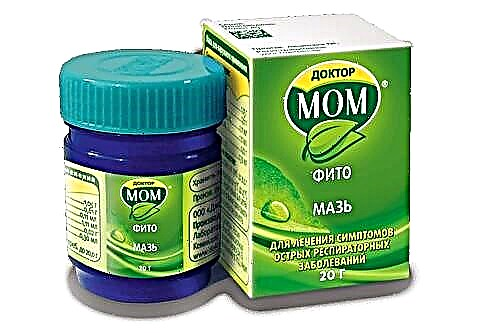Complementary feeding for babies is introduced, as a rule, in the second half of the year, so by eight months the baby's diet becomes quite diverse. From those products that are included in the children's diet, mom can always make a full menu for the week. Pediatricians warn that, despite complementary feeding, breast milk continues to occupy a significant place in baby food.

At eight months, baby's nutrition becomes varied
Features of complementary foods for an eight-month-old baby
By the eighth month, the baby perceives new tastes well, so the mother needs to continue to develop his taste sensations further. This will be helped by competent complementary foods for children of 8 months and a menu drawn up on its basis.
Advice! Children's nutritionists recommend at 8 months not to mix foods into a single dish, for example, mashed potatoes, but to cook each meal separately to develop taste and chewing ability.
A correctly composed menu for a baby should take into account the principles of complementary feeding and the peculiarities of cooking dishes for an 8 month old baby:
- Complementary foods are introduced if the child is healthy. Illness or recent vaccination is a reason to delay new dishes;
- If you are allergic to a new product, you must temporarily stop using it;
- The interval between the introduced products should be 3-4 weeks;
- Complementary feeding does not cancel breast milk or formula. Every day should begin and end with the usual crumbs.
Important! For complementary foods, it is undesirable to use liquid dishes, as they interfere with the habituation of the baby to solid food.
Breastfed
When the child reaches the age of eight months, along with the guards, he is introduced to the common table. Pediatricians advise to draw up a menu for an 8 month old breastfed baby so that the number of meals a day is at least 5 times: 3 of them are new dishes, 2 are familiar food. It is believed that this is the optimal routine for an eight month old baby, and nighttime breastfeeding is best kept to a minimum.
Bottle-fed
More recently, complementary foods were introduced to an artificial child at the age of 4 months. However, Dr. Komarovsky explains that early complementary feeding with artificial feeding was dictated by the peculiarity of infant formula, which was, in fact, diluted cow's milk. Modern milk formulas are as close as possible in composition to breast milk and are adapted for children. Therefore, there is no need for early feeding of an infant. For artificial children, it is administered in the same way as for infants who are on HV, at 6-8 months, according to the same rules.

The principles of complementary feeding are the same for children who are on different types of feeding
Considering complementary foods as solid food, WHO recommends its introduction only after 6 months. However, you should not postpone complementary foods until a later date, since it is quite difficult to do this by one year old.
In addition, late introduction of complementary foods is considered a violation of food stereotypes. The child gets used to eating only liquid food and continues to do so even at two years old. Also, by the age of one year, there may be a deficiency of vitamins, a lack of iron in the body. The optimal complementary feeding period is 6-8 months.
Complementary feeding errors
Pediatricians warn young mothers about the most common mistakes during complementary feeding:
- Premature completion of the Guards. It is recommended to continue breastfeeding as long as possible to protect the baby from allergies and obesity;
- Too rich food. Excess weight is not a reason for joy, on the contrary, it is a serious problem. Being overweight causes metabolic syndrome (deposition of excess visceral fat) and metabolic disorders;
- Violation of the terms of introduction. Some mothers give their babies dairy products and even cow's milk early. This is not necessary, since the infant receives the most useful milk - breast milk;
- The predominance of homemade baby food. The preference is given to finished products manufactured in compliance with all norms and rules.
The right food consistency for an 8 month old baby
Usually by 8 months, babies have 2 upper and 2 lower central incisors, which allows them to move on to solid foods. Pediatricians advise to make this transition smooth, which is easily achieved by gradually complicating the consistency from pureed food to solid food.
Council. Moms usually get upset when a child refuses a spoon and asks for a bottle. You need to be patient, as the baby needs to get used to the new taste and texture of the dishes.

A properly formulated diet for an 8-month-old child will help avoid vitamin deficiency or obesity
Is it possible to give food in pieces
The baby is ready to chew and swallow food after 6 months, when the pushing reflex fades away. However, mothers are afraid of the chewing process and try to delay the introduction of solid foods. Pediatricians recommend giving food in chunks from 8 months, when teeth begin to erupt.
Note. The shift to eating chunks isn't just driven by the need for new calories. Solid food trains the child's chewing apparatus and stimulates the development of the gastrointestinal tract, the motor function of the intestines, and forms taste habits. In addition, the baby develops the skills of biting off, chewing, and swallowing a piece of food.
What is included in the diet of an eight month old baby
Feeding a baby at the eighth month usually goes without difficulty, since the baby is happy to accept new dishes, especially if they have a pleasant taste. If the baby does not have tummy pains and colic, problems with stools and allergies, it can be fed with almost all foods.
Porridge in the baby's diet
Porridge made from different cereals is well suited for a second breakfast; they are a hearty dish and will saturate your baby for a long time. Usually, children are happy to eat various cereals, so the menu includes buckwheat, rice, corn grits, then pearl barley, oatmeal and semolina can be added for a change.
Council. Nutritionists advise adding a little butter for taste, since babies eat porridge much more willingly with this ingredient.
Vegetables for an eight month old baby
Most vegetables are already allowed to be eaten by eight months, so they are often used when making menus. All vegetables are considered useful for baby food, especially green ones: beans, peas, spinach, celery, zucchini. You can also add small pieces of butter to vegetable dishes.
Fruit in the children's menu
Just like vegetables, fruits in this age period are firmly included in baby food. The baby can taste all fruits, except for allergenic types, for example, citrus fruits. At the eighth month, children are offered fruit purees, juices and compotes.
Meat in the diet of an 8 month old baby
Nutritionists advise mothers to introduce meat products into the child's diet, since a growing body needs animal proteins. It can be beef, veal, chicken or rabbit, turkey. If your baby does not eat meat well, you can mix the meat puree with a product that he knows well, for example, add to vegetable puree.

Food in pieces is offered to babies at 8 months, when the teeth are teething
Fish dishes
At the age of eight months, the child is introduced to fish. It is recommended to include low-fat and white varieties such as cod or hake. Too often it is not worth giving fish dishes at eight months, it is better to do it 1-2 times a week.
Introduction of eggs into the diet of an 8 month old baby
Egg yolk is considered to be a supplier of valuable nutrients. However, it is advised to introduce it into the diet of young children, taking into account certain rules:
- Quail eggs are preferred, they almost do not cause allergies and are more useful;
- You need to start with a quarter of a chicken or half of a quail egg, pounded with breast milk;
- Include yolk in the diet no more than 2 times a week;
- It is useful to add to vegetable purees and soups.
Dairy products
Nutritionists remind about the value of fermented milk products: cottage cheese and kefir, as they help to strengthen bones and joints. Homemade yoghurts will benefit your baby. Cottage cheese in one feeding can be combined with fruit, it will be both tasty and healthy. Kefir for an eight-month-old baby can be replaced with one feeding, preferably in the evening.
Sample menu for a week
Correct introduction of new products and competent composition of the diet contribute to the good physical development of the baby. There are different menu options for an eight-month-old breastfed baby and for artificial children. However, they are all built according to the following rules:
- 5 meals a day, with the necessary observance of the portion size (1/8 of the body weight, excluding tea, water, juice);
- Morning feeding at 6.00 and evening feeding at 22.00, consisting of breast milk or an adapted formula.
Council. To help the young mother, the basis of the menu is offered, which can be adapted to the food preferences of her child.

A varied menu helps the baby to develop physically
Sample menu for an 8 month old baby for a week
| Days of the week | Meals | ||
|---|---|---|---|
| Second breakfast 10.00 | Lunch 14.00 | Dinner 18.00 | |
| Monday | Cottage cheese - 40 g, milk - 100-150 ml, fruit puree - 60 g | Vegetable puree - 150 g, a quarter of the yolk, meat puree - 30 g, juice - 40 ml | Milk porridge - 170 g, juice - 20 ml |
| Tuesday | Dairy-free porridge - 40 g, natural yogurt - 100-150 ml, fruit puree - 60 g | Vegetable soup - 150 g with the addition of 1 tsp. vegetable oil, poultry puree - 30 g, juice - 40 ml | Milk porridge with additives - 170 g, juice - 20 ml |
| Wednesday | Vegetable puree - 40 g, kefir - 100-150 ml, fruit puree - 60 g | Meat and vegetable puree - 150 g, a quarter of the yolk, juice - 40 ml | Milk porridge - 170 g, vegetable juice - 20 ml |
| Thursday | Cottage cheese - 40 g, fruit puree - 60 g, compote - 100-150 ml | Vegetable soup with the addition of cereals and 1 tsp of butter - 150 g, fish puree - 30 g, juice - 40 ml | Milk porridge - 170 g, fruit juice - 20 ml |
| Friday | Dairy-free porridge - 40 g, fruit puree - 60 g, baby tea or compote - 100-150 ml | Vegetable puree - 150 g, liver puree - 30 g, fruit juice - 40 ml | Milk porridge with additives - 170 g, juice - 20 ml |
| Saturday | Vegetable puree - 40 g, yogurt - 100-150 g, fruit puree - 60 g | Soup with the addition of cereals - 150 g, meat puree - 30 g, fruit and vegetable juice - 40 ml | Milk porridge - 170 g, fruit puree - 20 g |
| Sunday | Cottage cheese - 40 g, milk - 100-150 ml, fruit puree - 60 g | Vegetable puree - 150 g, a quarter of the yolk, meat puree - 30 g, juice - 40 ml | Milk porridge - 170 g, juice - 20 ml |
Cooking recipes for an eight month old baby
For those moms who prefer to cook nutritious meals on their own, you can refer to the recipes for an 8 month old baby presented on children's sites. The main thing is to keep a balanced diet. For example, you can make veal vegetable puree that requires:
- 1 potato;
- 70 g veal;
- 70 g pumpkin.
Cook the meat for 1.5 hours on low heat, then add vegetables and bring to readiness, pass through a blender.
Children love to eat soups that give them a new flavor. You can make meatball soup:
- 100 g turkey fillet;
- 30 g of rice;
- 1 potato;
- small onion;
- 50 g of cauliflower.
Add half-cooked rice to the turkey mince and form into small meatballs. Cook them for about 10 minutes, then add vegetables and cook the soup for another 10 minutes.

Cooking recipes will help mom organize a balanced diet for her baby
When composing a menu for a baby yourself, it is important to follow the basic rules of feeding. The nutrition of a baby 8 months old on artificial feeding and breastfeeding is about the same. The artificial person needs more full-fledged food, the baby can be fed in proportions of 50 to 50: breast milk and new food.



